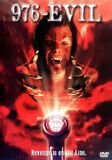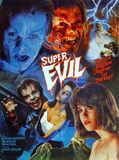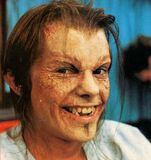| 976-EVIL | |
|---|---|
 German VHS art | |
| Vital statistics | |
| Directed by | Robert Englund |
| Produced by | Lisa M. Hansen |
| Written by | Rhet Topham Brian Helgeland |
| Screenplay by | |
| Story by | |
| Based on | |
| Starring | Stephen Geoffreys Patrick O'Bryan Sandy Dennis Robert Picardo Jim Metzler Maria Rubell Lezlie Deane Cynthia Szigeti Jim Thiebaud |
| Music | Thomas Chase Steve Rucker |
| Release date(s) | December 9, 1988 (UK) March 24, 1989 (USA) |
| Running time | 92 mins (theatrical version) 105 mins (VHS Version) |
| Country | United States |
| Budget | |
| Gross revenue | $2,955,917 (USA) |
976-Evil is a 1988 horror movie starring Stephen Geoffreys. Although the character he portrays is quite different, the title cemented Geoffreys as "Evil" in the consciousness of horror fans. The movie is also notable because Geoffreys turned down the opportunity to appear in Fright Night Part 2 so he could star in this film.
The title refers to the 976 telephone exchange, a now mostly defunct premium-rate telephone number system which was popular in the late 1980s and was superseded by area code 900.
Story[]
The movie centers around cousins Spike (Patrick O'Bryan) and Hoax (Stephen Geoffreys), both teenagers who live with Hoax's overtly religious mother Lucy (Sandy Dennis). While Spike is the neighborhood motorcycle bad boy, Hoax is an introverted nerd. Even though Spike genuinely cares for his cousin and protects him from bullies, Hoax is filled with resentment that he cannot stand up for himself or get the girl he wants (both of which Spike does effortlessly).
Both boys stumble upon 976-EVIL, which on the surface is just a novelty phone line that gives creepy-themed fortunes for a few dollars. However, the line is actually used by Satan to subtly corrupt mortals into his bidding. Spike loses interest in the line quickly, but Hoax soon discovers the true nature of the line and uses it to get revenge on everyone who has wronged him.
Soon Hoax's spirit is almost entirely consumed by Satan, who possesses Hoax to cause death and destruction, culminating in an opening to Hell appearing before their house. Spike confronts Hoax, but is quickly overpowered. In a desperate last ploy, he calls earnestly to his cousin, reminding him of the plans they had to take a vacation that summer.
Hoax's fleeting soul resurfaces briefly, and realizes his horrible mistake and embraces Spike, begging for help. Spike, realizing Hoax is lost and cannot be separated from the demonic presence, betrays his cousin and throws him into the pit of Hell.
Releases[]
The film was released theatrically in the United States by New Line Cinema in March 1989. It grossed $2,955,917 at the box office.[1]
The film was released on home video by RCA/Columbia Pictures Home Video later the same year. VHS and laserdisc versions of the film are uncut and contain footage previously unseen in its original theatrical release.
Deleted Scenes[]
The version of the film released on VHS/laserdisc ran a whopping 13 minutes longer than the theatrical/DVD/digital-download version. More additional and alternate footage also surfaced in the American television print.
The extra scenes primarily consist of character development and establishing shots. Marty interviews Aunt Lucy and Hoax, Suzie and Spike flirt and catch Hoax snooping in Spike's room, and Angela Martinez has several additional scenes. In Germany, the extended version was issued on a 2-DVD set. Oddly, though most of the film is in English, a few scenes on this set were dubbed with German dialogue.










